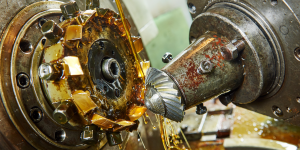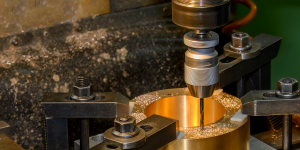L'un des aspects les plus cruciaux de la fabrication moderne est l'usinage de précision. La fabrication moderne utilise des pièces complexes et précises pour divers secteurs à travers des méthodes et des outils avancés. L'usinage de précision joue un rôle clé dans la qualité, précision, et vitesse d'un produit.
Usinage de précision - comment ça marche?
L'usinage de précision est le processus de prise d'un morceau de matériau et de retirer sa quantité précise afin de former la forme nécessaire. CNC (Commande numérique par ordinateur) La machine est utilisée pour effectuer des coupes et des mouvements exacts en fonction des plans numériques.
Une conception ou un plan détaillé est converti en un programme informatique qui indique à la machine quoi faire. La machine, Afin de façonner et de dimensionner la pièce, utilise des exercices, moulins, et des tours pour enlever le matériel.

Avantages de l'usinage de précision dans la fabrication
Parmi les nombreux avantages de l'usinage de précision, Le plus notable est l'efficacité de la production du processus de fabrication. L'un des avantages essentiels de la technologie de pointe est la précision et la précision. Par l'usinage de précision, Les fabricants sont capables de fabriquer des pièces avec des tolérances étroites et une grande précision et donc, Chaque partie s'intégrerait parfaitement dans le produit final.
Encore, Un autre avantage de l'usinage de précision est la réduction des coûts. Un exemple de ceci est l'usinage de précision qui nécessite des outils et des travaux spécialisés, mais peut aussi économiser de l'argent à long terme. Haute précision et précision de l'usinage de précision excluent le gaspillage matériel, reprise, et réparation, ce qui réduit considérablement les coûts de fabrication.
Connaissance des méthodes d'usinage de précision
- Usinage CNC: L'usinage CNC est l'une des méthodes d'usinage de précision les plus populaires où il s'agit d'une machine contrôlée par ordinateur qui supprime le matériel d'une pièce. Sa précision, réplicabilité, ainsi que l'adaptabilité, faire pour être utilisé dans de nombreuses applications.
- Usinage à décharge électrique (EDM): Cette technologie de non-convention applique des étincelles électriques pour éliminer le matériel d'une pièce. Il est capable de couper des matériaux très complexes et durs que les technologies traditionnelles ne peuvent pas gérer.
- Découpe au laser: Un outil laser avancé peut couper des matériaux avec une grande vitesse et une grande précision. Ce laser est capable de faire des coupes propres sur les métaux, polymères, et les composites.
- Découpe au jet d'eau: Un jet d'eau contenant des particules abrasifs crée un ruisseau à haute pression qui coupe les matériaux. Il peut être trouvé dans les métaux, polymères, pierres, et verre.
- Affûtage: Les roues abrasives dans l'usinage de précision sont utilisées pour l'élimination du matériau d'une pièce. Plusieurs industries en dépendent pour la finition des surfaces délicates et pour obtenir des tolérances étroites.
Sélection de la bonne méthode d'usinage de précision pour votre projet
Beaucoup de choses doivent être prises en compte lorsque vous décidez de la technologie d'usinage de précision qui convient le plus à votre projet. Ce sont la complexité du design, type de matériau, degré de précision, et finition de surface. Adapter l'approche du projet est impératif pour le résultat le plus efficace.
Une consultation avec un professionnel de l'usinage de précision avant de sélectionner un processus est conseillé. Prendre l'avantage de leurs compétences d'usinage, Un professionnel chevronné peut vous donner des recommandations importantes. Ils peuvent être eux pour évaluer les exigences d'un projet et proposer le plan le plus efficace pour atteindre l'objectif.
Importance de l'usinage de précision Contrôle de la qualité
L'usinage de précision nécessite un contrôle de qualité. Il s'agit de plusieurs étapes pour s'assurer que chaque composant répond aux exigences et aux normes. Le contrôle de la qualité commence à la conception et se poursuit tout au long de la fabrication.
L'usinage de précision nécessite un contrôle de qualité pour la précision et la cohérence. Les fabricants peuvent détecter les déviations et les défauts tôt et les réparer pour préserver la précision en utilisant des méthodes d'inspection strictes. Cela empêche la reprise coûteuse ou la ferraille et assure la qualité des composants.
Matériaux d'usinage de précision communs
La précision d'usinage peut être effectuée sur plusieurs matériaux tant que le travail l'exige. L'usinage de précision utilise différents types de métaux, polymères, Composites et céramiques.
Les caractéristiques mécaniques de l'aluminium, acier, Et le titane les a rendus populaires dans l'usinage. Les plastiques sont principalement utilisés dans l'usinage de précision pour être léger, Isulant résistant à la corrosion et électrique.

Composites, qui sont formés en mélangeant deux ou plusieurs éléments, est utilisé dans différentes industries. Ils ont une caractéristique distincte d'avoir un rapport force / poids et une résistance à la corrosion et à la fatigue.
Des projets d'usinage de précision à haute demande qui appellent à une résistance à une résistance extrême et à une résistance aux céramiques à la fois fortes et résistantes à la chaleur.
Tendances et innovations futures d'usinage de précision
La technologie et la production ainsi que l'efficacité exigent le développement de l'usinage de précision. Il existe de nombreuses tendances et innovations qui vont changer l'usinage de précision.
L'intelligence artificielle et les algorithmes d'apprentissage automatique transforment le rôle de usinage de précision. Ces technologies permettent aux machines d'apprendre des données, optimiser les paramètres de coupe, et le changement en temps réel pour des raisons de précision et d'efficacité.
L'automatisation et la robotique seront également décisives dans le processus d'usinage exact. L'automatisation peut effectuer de nombreuses opérations encore et encore, Il y aura donc moins d'erreurs humaines et une plus grande efficacité. En utilisant des cobots, qui sont des robots qui peuvent effectuer les mêmes tâches que les humains mais avec une précision plus élevée, L'usinage de précision devient de plus en plus efficace et plus sûr.
L'intégration du processus de fabrication est une autre tendance. La précision de l'usinage est fréquemment combinée avec une fabrication additive (3D Impression) Pour atteindre précis, pièces délicates.
Enfin et surtout, L'usinage de précision est la clé de la fabrication moderne. Les avantages sont une précision améliorée, efficacité, réduire les coûts, et maintenir le même niveau de qualité. Les fabricants peuvent utiliser l'usinage de précision à leur propre avantage en étudiant les différentes techniques, Considérer les exigences du projet, Travailler avec des spécialistes, Mise en œuvre des mesures de contrôle de la qualité, Ramasser des matériaux correspondants et suivre les tendances et les innovations.
